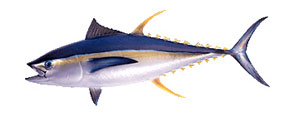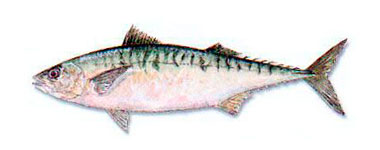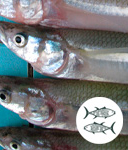
FROZEN FISH
TUNA | MACKEREL | SARDINE
 Tuna:Within this genus (Thunnus)we can provide Bluefin Tuna (Thunnus thynnus),Yellowfin Tuna (Thunnus Albacares),Albacora (Thunnus alalunga)and others of similar characteristics, such as the "Kite”(Katsuwonus Pelamis)and the "Atlantic Bonito" (Sarda sarda),which are marketed worldwide under the name of Tuna. These varieties are commercialized either whole, raw, frozen or as precooked and frozen loins. In cartons or in double polypropylene bags.
Tuna:Within this genus (Thunnus)we can provide Bluefin Tuna (Thunnus thynnus),Yellowfin Tuna (Thunnus Albacares),Albacora (Thunnus alalunga)and others of similar characteristics, such as the "Kite”(Katsuwonus Pelamis)and the "Atlantic Bonito" (Sarda sarda),which are marketed worldwide under the name of Tuna. These varieties are commercialized either whole, raw, frozen or as precooked and frozen loins. In cartons or in double polypropylene bags.General information on tuna:
Of course Tuna is not the size of the canned tuna people buy. Together with sturgeons, tuna is among the largest fish that compete with other animals, such as sharks and dolphins. One of the largest is the “bluefin tuna” which lives in the Atlantic and can grow to 3 meters in length and weigh 680 kilograms. In warm seas, where they are very abundant, they are smaller, they can weigh between 15 and 100 kilograms, and their size goes from 40 centimeters to one meter, as is the case of "Bonito" and "Kite" tuna. The "yellowfin tuna" and "bigeye tuna" reach a maximum size of 190 centimeters.
 Mackerel:Educao provides the Central American commercial varieties from Ecuador and Mexico “Scomber scombrus” and “Scomber japonicus”. The product is frozen; whole, whole gutted, or HGT; and packaged in double polypropylene bags.
Mackerel:Educao provides the Central American commercial varieties from Ecuador and Mexico “Scomber scombrus” and “Scomber japonicus”. The product is frozen; whole, whole gutted, or HGT; and packaged in double polypropylene bags.
General information about Mackerel:
They are fish of the genus (Scomber) which is made up of several species that are commercialized under the name of Mackerel. The Atlantic Mackerel itself (Scomber scombrus), or Mackerel (Scomber Japonicus), usually lives in continental shelf waters, and oceanic incursions are rare among this species. It is a lucifuga species so it rises to the surface at night. Its size varies between 25 to 35 cm., and, in some exceptional cases, they reach 45 cm. Its maximum weight is 3,4 kg.
Sardine:Educao S.R.L. provides sardines (varieties described below) and anchovetas (Engraulis mordax) from its represented company in Mexico. They are frozen, whole, and packed in double polypropylene bags.

General information about Sardines:
The most important Mexican species are the “Monterey sardine” (Sardinops sagax caerulea) and the "Crinuda sardine" (Ophistonema libertate), which make up 90% of the national catch, although the "Japanese sardine" (Etreumess teres) and the "Big-mouth Sardine" (Cetengragraulis mysticetus) can also be caught.
 Anchovetas belong to the genus Engraulis that characterizes the family; they are pelagic fish of major fishing importance due to the great volumes of annual catch in the different seas of the planet.
Anchovetas belong to the genus Engraulis that characterizes the family; they are pelagic fish of major fishing importance due to the great volumes of annual catch in the different seas of the planet.
Their body is similar to that of the sardine, but more cylindrical, uncompressed and with wide muscles that enable to obtain thick fillets that can be salted easily. In some countries, like Chile, this sardine is called "Big-Mouth Sardine".








